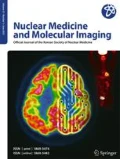Abstract
Targeted radionuclide therapy (TRT) is unique because of its efficacy and its theranostic feature in the era of precision medicine. So far, introduction of new TRT has not been going well in Japan due to several reasons including strict regulations, shortage of facilities for TRT, and insufficient reimbursement for TRT in clinic. Japanese community had several strategies to develop TRT in these 10 years, including the establishment of the National Conference for Nuclear Medicine Theranostics in which physicians, scientists, patients, people supporting patients, and industrial people gather. To promote TRT with supports from the government, the preparatory committee for the establishment of Japan Foundation of Medical Isotope Development (JAFMID) was launched. I would like to call TRT “Precision Nuclear Medicine.” When we can add genomic information here, we can put it to new stage of cancer therapy. It is time for us.
Similar content being viewed by others
References
Kusakabe K, Yokoyama K, Ito K, Shibuya H, Kinuya S, Ito M, et al. Thyroid remnant ablation using 1,110 MBq of I-131 after total thyroidectomy: regulatory considerations on release of patients after unsealed radioiodine therapy. Ann Nucl Med. 2012;26:370–8.
Hosono M, Ikebuchi H, Nakamura Y, Yanagida S, Kinuya S. Introduction of the targeted alpha therapy (with Radium-223) into clinical practice in Japan: learnings and implementation. Ann Nucl Med. in press. https://doi.org/10.1007/s12149-018-1317-1.
Kinuya S, Yoshinaga K, Higuchi T, Jinguji M, Kurihara H, Kawamoto H. Guideline Drafting Committee for Radiotherapy with 131I-MIBG, Committee for Nuclear Oncology and Immunology, the Japanese Society of Nuclear Medicine. Draft guidelines regarding appropriate use of 131I-MIBG radiotherapy for neuroendocrine tumors : Guideline Drafting Committee for Radiotherapy with 131I-MIBG, Committee for Nuclear Oncology and Immunology, The Japanese Society of Nuclear Medicine. Ann Nucl Med. 2015;29:543–52.
Hosono M, Ikebuchi H, Nakamura Y, Nakamura N, Yamada T, Yanagida S, et al. Manual on the proper use of lutetium-177-labeled somatostatin analogue (Lu-177-DOTA-TATE) injectable in radionuclide therapy (2nd ed.). Ann Nucl Med. 2018;32:217–35.
Yoshii Y, Matsumoto H, Yoshimoto M, Zhang MR, Oe Y, Kurihara H, et al. Multiple administrations of 64Cu-ATSM as a novel therapeutic option for glioblastoma: a translational study using mice with xenografts. Transl Oncol. 2018;11:24–30.
Ohshima Y, Sudo H, Watanabe S, Nagatsu K, Tsuji AB, et al. Antitumor effects of radionuclide treatment using α-emitting meta-211At-astato-benzylguanidine in a PC12 pheochromocytoma model. Eur J Nucl Med Mol Imaging. 2018;45:999–1010.
Kunikowska J, Pawlak D, Bąk MI, Kos-Kudła B, Mikołajczak R, Królicki L. Long-term results and tolerability of tandem peptide receptor radionuclide therapy with 90Y/177Lu-DOTATATE in neuroendocrine tumors with respect to the primary location: a 10-year study. Ann Nucl Med. 2017;31:347–56.
Escala Cornejo RA, García-Talavera P, Navarro Martin M, Pérez López B, García Muñoz M, Tamayo Alonso MP, et al. Large cell neuroendocrine carcinoma of the lung with atypical evolution and a remarkable response to lutetium Lu 177 dotatate. Ann Nucl Med. 2018;32:568–72.
Werner RA, Bundschuh RA, Bundschuh L, Javadi MS, Higuchi T, Weich A, et al. Molecular imaging reporting and data systems (MI-RADS): a generalizable framework for targeted radiotracers with theranostic implications. Ann Nucl Med 2018;32:512–22.
Mair C, Warwitz B, Fink K, Scarpa L, Nilica B, Maffey-Steffan J, et al. Radiation exposure after 177Lu-DOTATATE and 177Lu-PSMA-617 therapy. Ann Nucl Med. 2018;32:499–502.
Şimşek DH, Şanlı Y, Kuyumcu S, Başaran B, Mudun A. 68Ga-DOTATATE PET–CT imaging in carotid body paragangliomas. Ann Nucl Med. 2018;32:297–301.
Watanabe M, Nakamoto Y, Koyasu S, Ishimori T, Yasoda A, Togashi K. The influence of elevated hormone levels on physiologic accumulation of 68Ga-DOTATOC. Ann Nucl Med 2018;32:191–6.
Nakamoto Y, Ishimori T, Sano K, Shimizu Y, Togashi K. Clinical feasibility of early scanning after administration of 68Ga-DOTATOC. Ann Nucl Med. in press. https://doi.org/10.1007/s12149-018-1304-6.
Sanli Y, Kuyumcu S, Sanli O, Buyukkaya F, İribaş A, Alcin G, et al. Relationships between serum PSA levels, Gleason scores and results of 68Ga-PSMAPET/CT in patients with recurrent prostate cancer. Ann Nucl Med. 2017;31:709–17.
Werner RA, Sheikhbahaei S, Jones KM, Javadi MS, Solnes LB, Ross AE, et al. Patterns of uptake of prostate-specific membrane antigen (PSMA)-targeted 18F-DCFPyL in peripheral ganglia. Ann Nucl Med. 2017;31:696–702.
Campbell SP, Baras AS, Ball MW, Kates M, Hahn NM, Bivalacqua TJ, et al. Low levels of PSMA expression limit the utility of 18F-DCFPyL PET/CT for imaging urothelial carcinoma. Ann Nucl Med. 2018;32:69–74.
Ringheim A, Campos Neto GC, Martins KM, Vitor T, da Cunha ML, Baroni RH. Reproducibility of standardized uptake values of same-day randomized 68Ga-PSMA-11 PET/CT and PET/MR scans in recurrent prostate cancer patients. Ann Nucl Med. 2018;32:523–31.
Komek H, Can C, Yilmaz U, Altindag S. Prognostic value of 68Ga PSMA I&T PET/CT SUV parameters on survival outcome in advanced prostat cancer. Ann Nucl Med. 2018;32:542–52.
Kircher M, Herhaus P, Schottelius M, Buck AK, Werner RA, Wester H-J, et al. CXCR4-directed theranostics in oncology and inflammation. Ann Nucl Med. 2018;32:503–11.
Joraku A, Hatano K, Kawai K, Kandori S, Kojima T, Fukumitsu N, et al. Phase I/IIa PET imaging study with 89zirconium labeled anti-PSMA minibody for urological malignancies. Ann Nucl Med. https://doi.org/10.1007/s12149-018-1312-6.
Acknowledgements
None.
Author information
Authors and Affiliations
Corresponding author
Ethics declarations
Conflict of Interest
Seigo Kinuya declares no conflict of interest.
Ethical Approval
This is a kind of commentary that ethical approval is not required.
Informed Consent
This manuscript does not contain any human study so informed consent should not be applied.
Additional information
Publisher’s Note
Springer Nature remains neutral with regard to jurisdictional claims in published maps and institutional affiliations.
Rights and permissions
About this article
Cite this article
Kinuya, S. Activities for the Development of Targeted Radionuclide Therapy in Japan. Nucl Med Mol Imaging 53, 35–37 (2019). https://doi.org/10.1007/s13139-018-0563-4
Received:
Revised:
Accepted:
Published:
Issue Date:
DOI: https://doi.org/10.1007/s13139-018-0563-4



